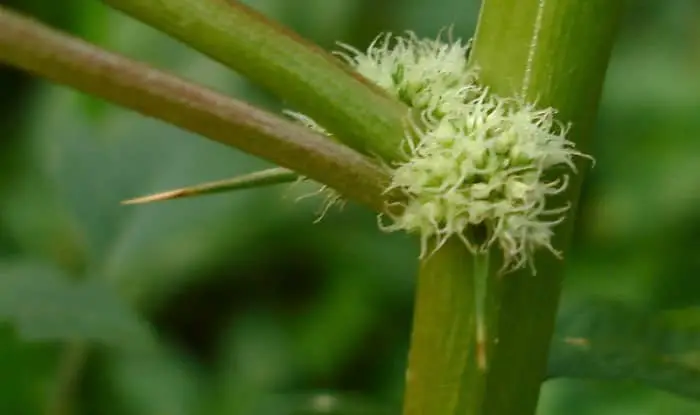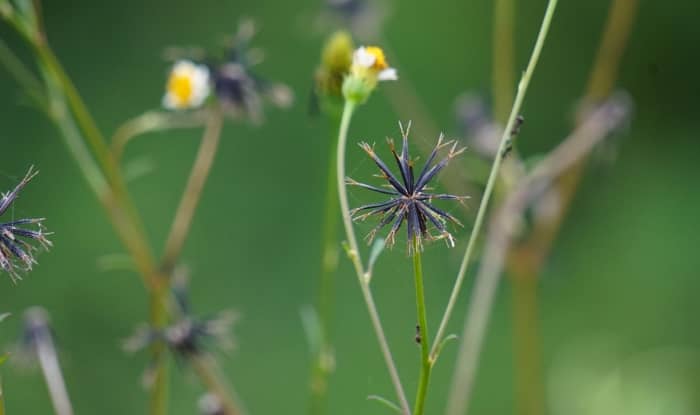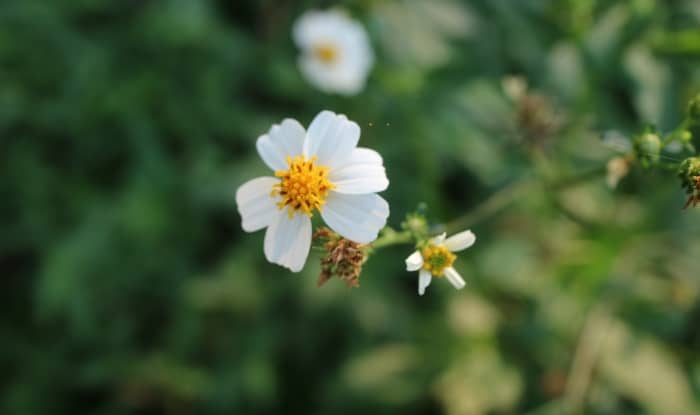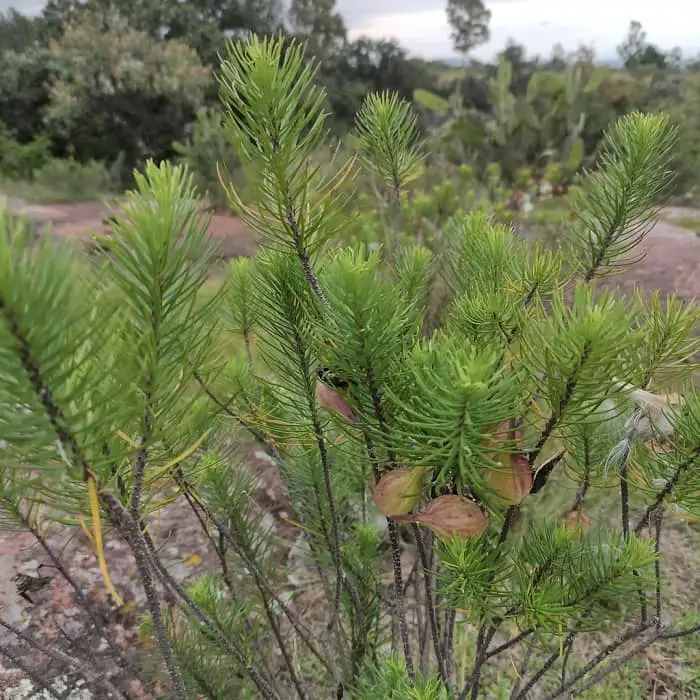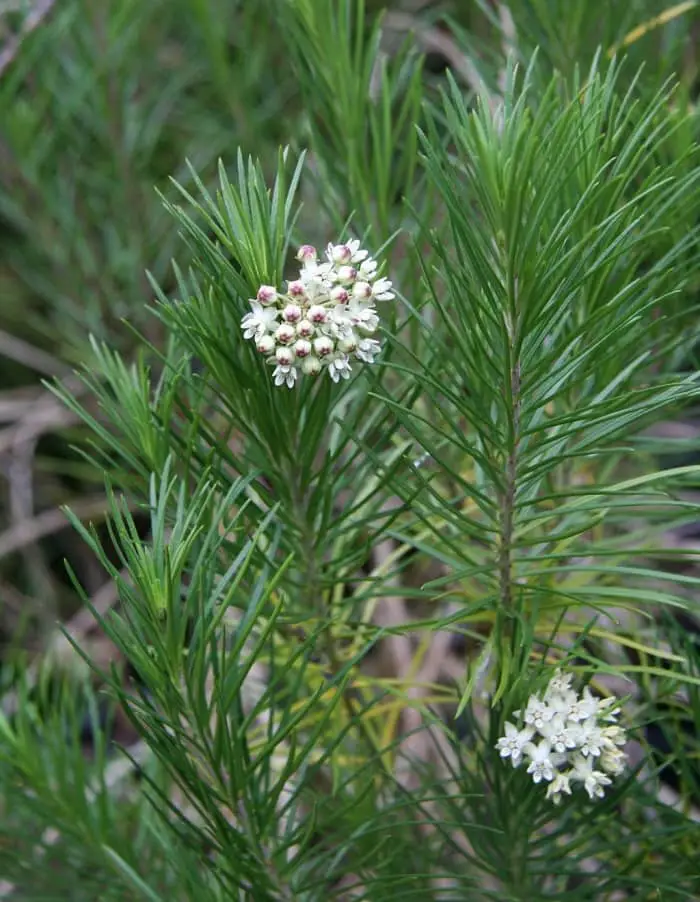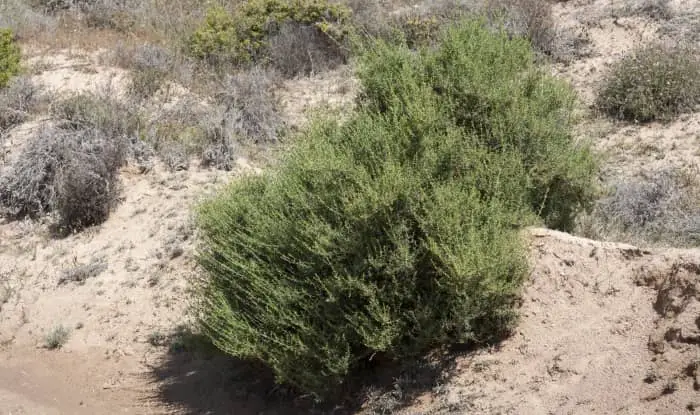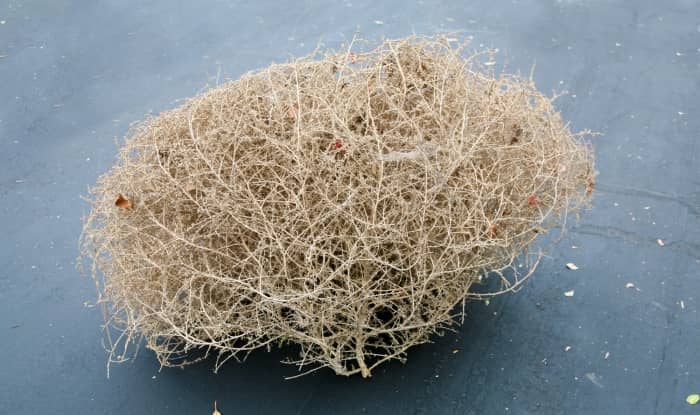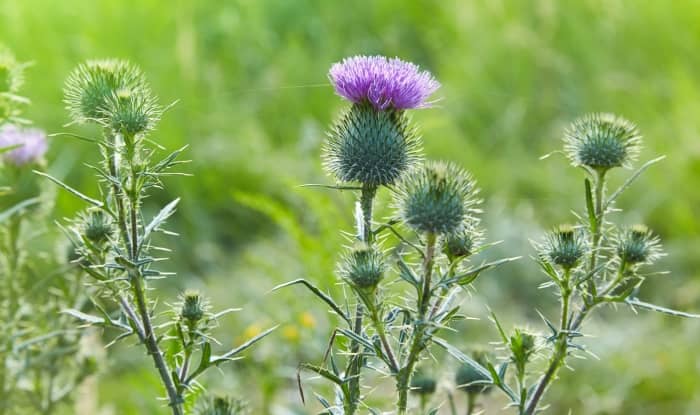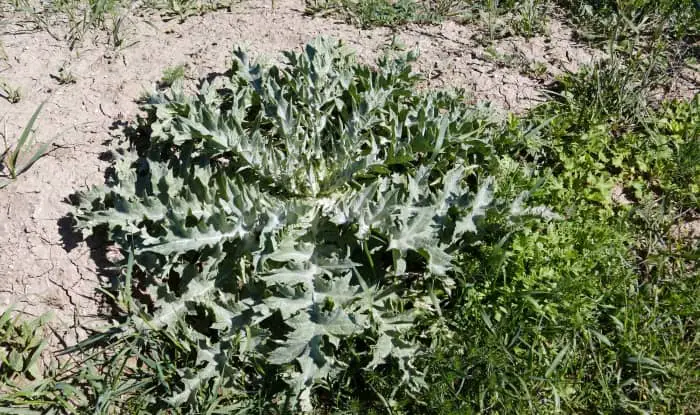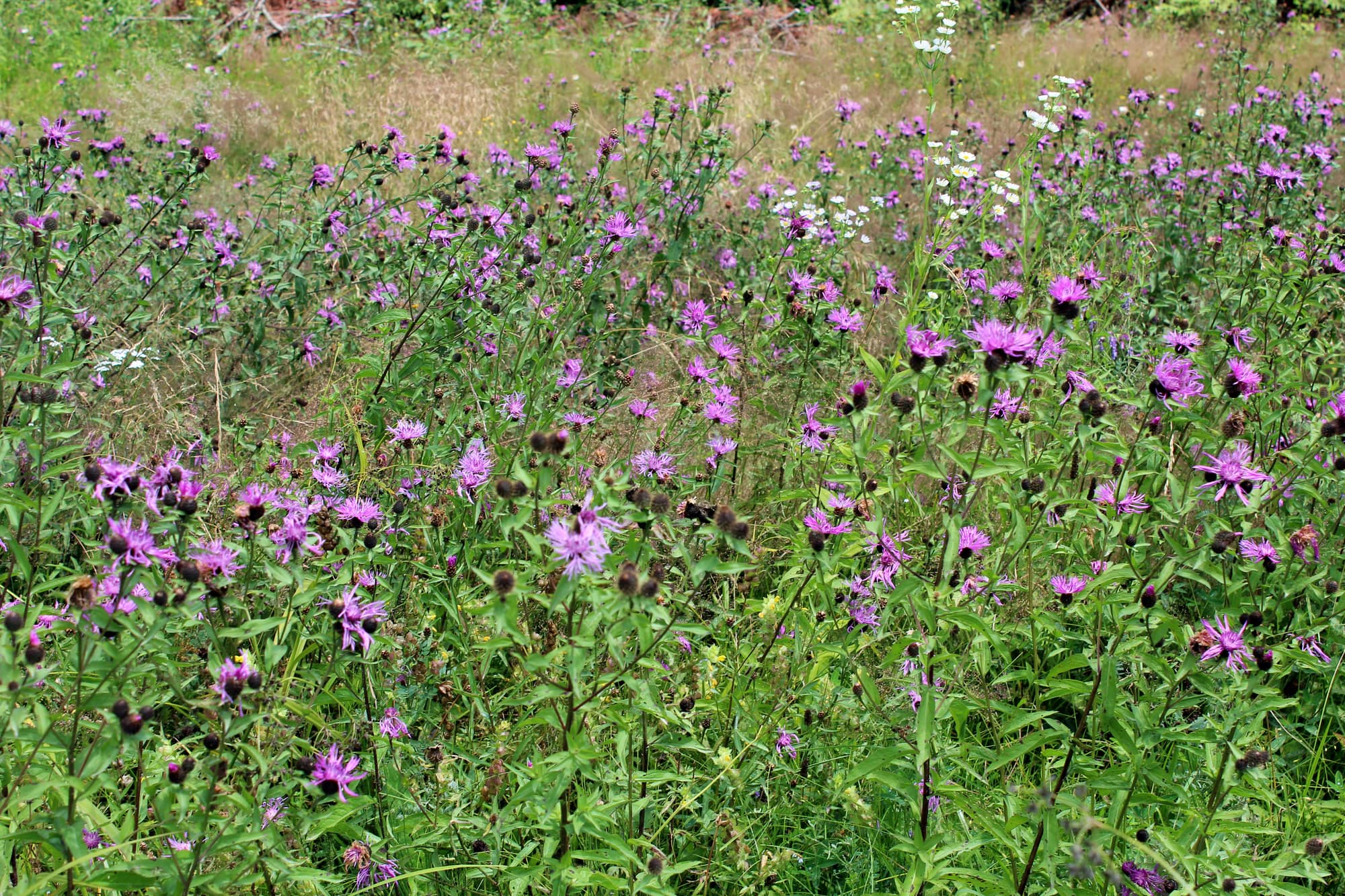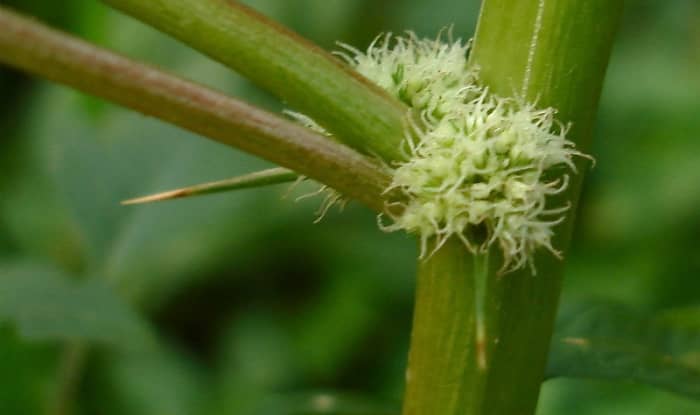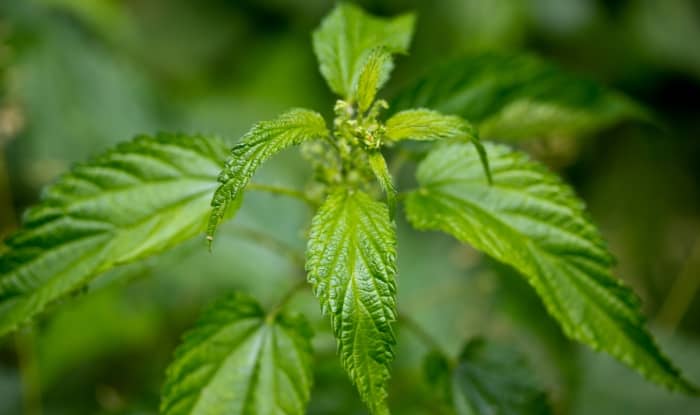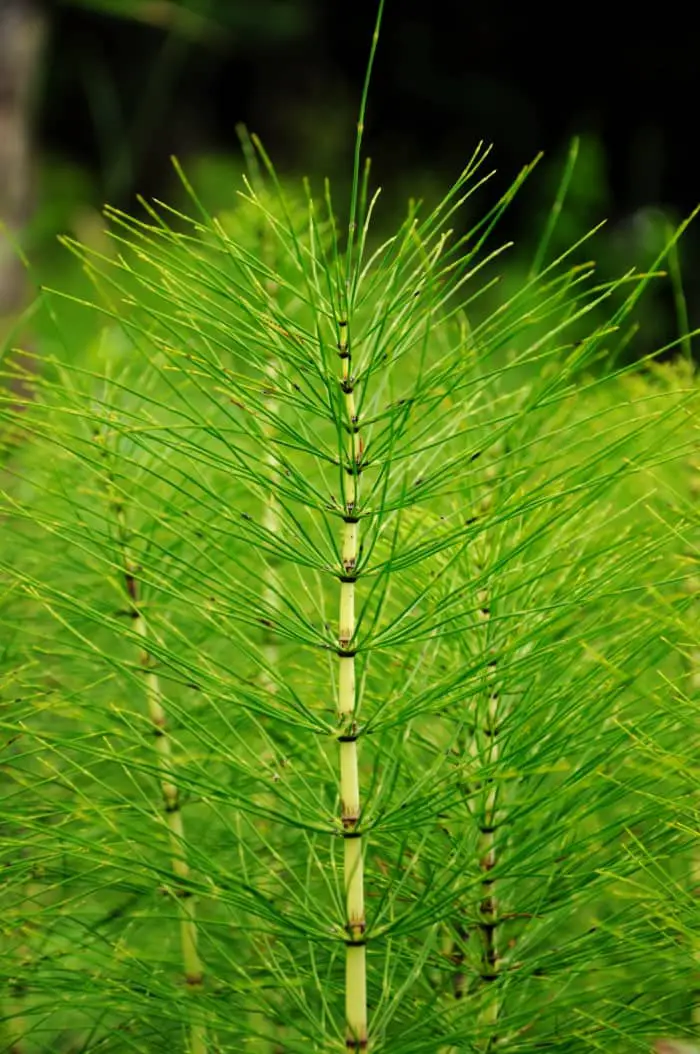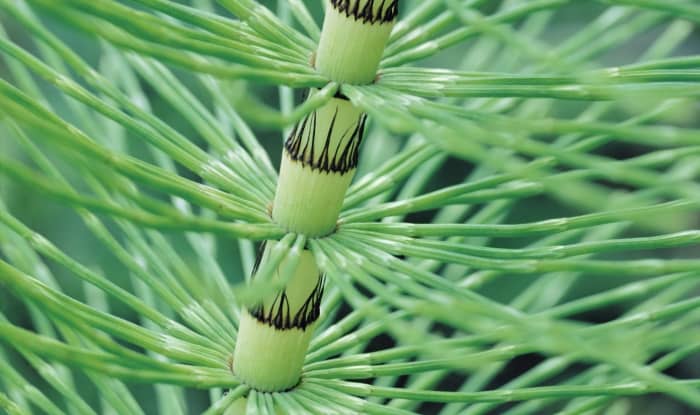Have you found some weeds with needles?
I’ll help you identify them using photos and detailed descriptions.
Let’s dive in.
Weeds With Needles
Some weeds have sharp needle-like spines growing from leaves and stems. Other weeds have seeds, leaves, or branches that resemble needles.
I’ll show you examples of the different types. Here are some of the common weeds with needles:
Spanish Needles (Bidens spp.)
Spanish needles is also known as shepherd’s needles, beggarticks, or butterfly needles. Many different Bidens species look similar and go by the same colloquial names. You can find them growing in North America, Central and South America, and parts of Europe, Asia, and Africa. Two of the most common are Bidens alba and B. pilosa (1).
If you’ve found a weed with black needles growing in your yard, Spanish needles could be the culprit. You can recognize the weeds by the needle-like seeds with barbed thorns that stick to clothing, shoes, hair, and fur.
Each plant produces between 3000-6000 viable seeds, so hand pull the weed or use a systemic herbicide as soon as you find it to prevent it from spreading. Spanish needles spreads aggressively. But you can control its spread by mowing seedlings regularly before they have a chance to set seed.
When in bloom, the weed develops small white flowers with 4-5 petals surrounding a yellow disc floret. Usually, B. pilosa flowers have a disc floret and no petals.
Heartleaf Nettle (Urtica chamaedryoides)
Also called dwarf stinging nettle and fireweed, heartleaf nettle has needle-like hairs along its leaves and stems, making it painful to touch. A brush with heartleaf nettle can lead to contact dermatitis, with the pain lasting up to 2 days.
The weed is native to the Southeastern United States and northern Mexico, where it often grows in rich woods, disturbed areas, and flood plains. In some parts of Florida, the heartleaf nettle grows as a pasture and lawn weed.
Similar to other species of nettles, the weed produces small green flowers pollinated by the wind. The leaves resemble a young strawberry plant. And the seeds have a sticky coating that enables them to attach to clothing, fur, and machinery to transport to new locations, allowing the weed to easily spread.
Pineneedle Milkweed (Asclepias linaria)
ASCLEPIAS LINARIA BY WOKRFCM, CC BY-SA 4.0, VIA WIKIMEDIA COMMONS
Also called pine-leaf milkweed and needle-leaf milkweed, pineneedle milkweed is a woody shrub found in parts of the Southern United States and throughout central and northern Mexico.
The plant grows up to 5 ft. tall, with erect, branched stems. The leaves of the weed look like pine needles, hence the name. From February to October, the plant blooms, producing greenish-white or white flowers.
CC BY-SA 3.0, VIA WIKIMEDIA COMMONS
You’ll usually find pineneedle milkweed growing on dry, rocky slopes and mesas at an altitude between 1,500 to 6,000 ft.
Russian Thistle (Salsola spp.)
Also called tumbleweed, Russian thistle is a summer-annual weed native to southeastern Russia and western Siberia. It was first introduced to the United States in the 19th century, after which it spread quickly by seed. The weed is now common throughout the western United States.
The weed grows large and bushy, with slender ascending stems that reach up to 36 inches long and become woody as they mature. The stems have reddish to purplish stripes.
Russian thistle seedlings have fine leaves that resemble pine needles (2). As the young plants grow, the leaves become fleshy but remain narrow, reaching 1 inch in length. Older leaves become stiff and sharp at the tip.
Russian thistle is considered a noxious weed. Some Salsola species accumulate high levels of oxalates that can be toxic when eaten by livestock, particularly sheep. The weed can also cause a fire hazard when the main stem breaks and the plant dries up. In this form, the weed is known as tumbleweed and can also obstruct traffic.
You’ll usually find Russian thistle growing in disturbed sites, along fence lines, highways, and waste ground.
Bull Thistle (Cirsium vulgare)
Bull thistle is notorious for being a weed with huge needle-like spines that grow at the tips of large lobed leaves and from the stems. The spines are sharp, making bull thistle plants painful to touch. Spiny bracts also grow under the flower heads.
Bull thistles are biennial weeds that grow a basal rosette of leaves in the first year before growing a central stem in the second year that can reach 7 ft. tall.
The weed flowers in the second year, developing distinctive purple-pink flower heads.
Bull thistles grow in a variety of conditions but do best in locations with rich soil and plenty of sunshine.
Canada Thistle (Cirsium arvense)
Also known as stinger needles and creeping thistle, Canada thistle is a perennial weed native to North Africa, Western Asia, and Europe, now found worldwide in suitable climates.
Introduced to the United States in the 17th century, Canada thistle is considered a noxious weed in many US states.
The weed grows up to 5 ft. high with upright stems. At the end of the stems, purple-pink flowers develop. Sharp needle-like spines cover the leaves and base of the flowers.
The weed spreads through lateral root growth. As the root system expands, new vertical shoots emerge from the ground leading to dense thistle colonies. The weed is also a prolific producer of seeds making Canada thistle hard to control.
Needle burr (Amaranthus spinosus)
Also known as spiny amaranth, needle burr is an annual broadleaf weed in the pigweed family that stands apart from similar species because of the sharp needle-like thorns on its stems.
You can also identify this weed with needles by its reddish stem with alternate, ovate leaves growing from long petioles. The hairless leaves grow from 1.25-2.5 inches long. Growing from the base of the leaf petioles are needle-like spines that grow to 1-2 cm (3).
AMARANTHUS SPINOSA BY LAUREN GUTIERREZ
From May to October, needle burr blooms, producing small yellow-green flowers.
It’s common to see needle burr growing in pastures and hayfields, but it’s unpalatable for grazing animals because of its toxic foliage and spines.
Stinging Nettle (Urtica dioica)
Most people have a brush with stinging nettles at some point in their life. This herbaceous perennial weed is well-known for the pain delivered by the tiny needle-like hairs that grow from its leaves.
The leaves are green with serrated edges and grow up to 6 inches long. They grow oppositely on a wiry, green stem. Small greenish-white flowers appear when the weed blooms in the summer.
Stinging nettles are invasive weeds that spread through rhizomes and seeds, making it difficult to control once the weed becomes established in your garden.
Horsetail (Equisetum arvense)
Horsetail is an ancient invasive weed with wiry stems and whorls of needle-like leaves (4).
Horsetail spreads by rhizomes and spores and forms a dense carpet of foliage that can crowd out and displace less competitive, desirable plants in your yard. The weed has roots that extend deep into the ground, making it difficult to remove.
The herbaceous weed grows up to 60cm tall but dies in winter before new shoots emerge from the ground in the spring.
References:
- Biology And Management Of Spanish Needles (Bidens Spp.) In Ornamental Crop Production – https://edis.ifas.ufl.edu/publication/EP572
- Russian Thistle – http://ipm.ucanr.edu/PMG/PESTNOTES/pn7486.html
- Amaranthus spinosus L. – https://apps.lucidcentral.org/rainforest/text/entities/amaranthus_spinosus.htm
- Distribution And Biology Of Horsetail In The UK – https://ahdb.org.uk/knowledge-library/distribution-and-biology-of-horsetail-in-the-uk
